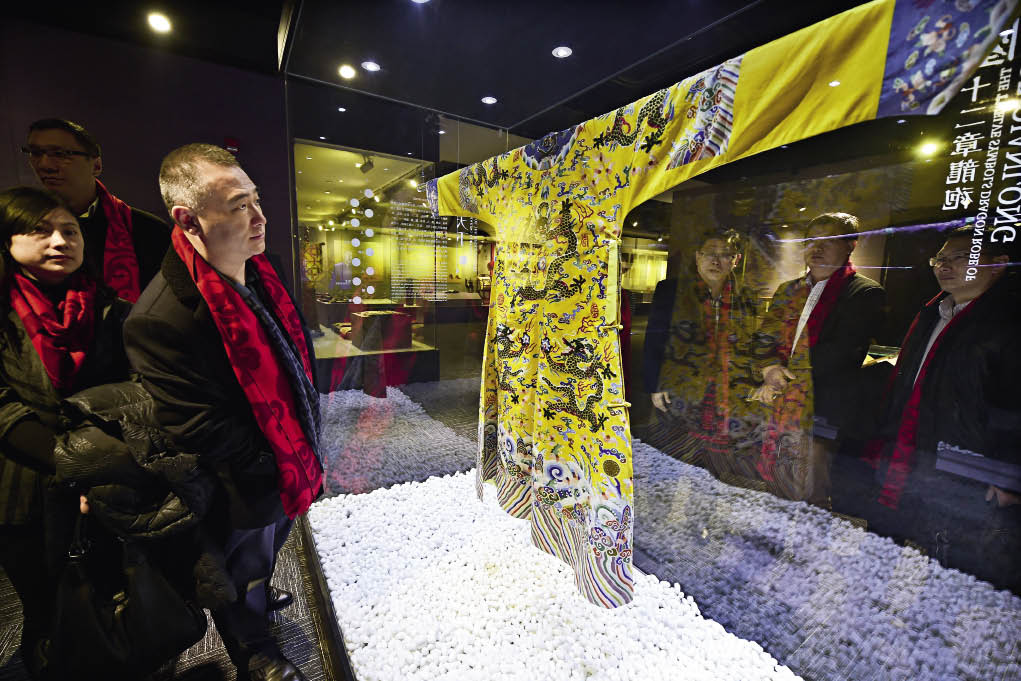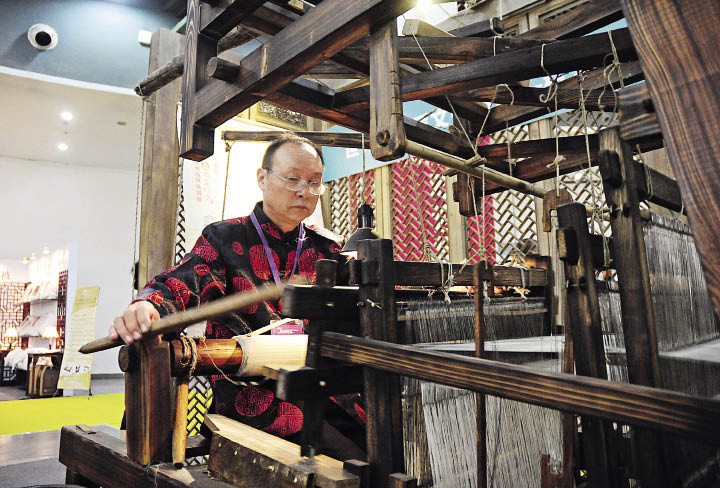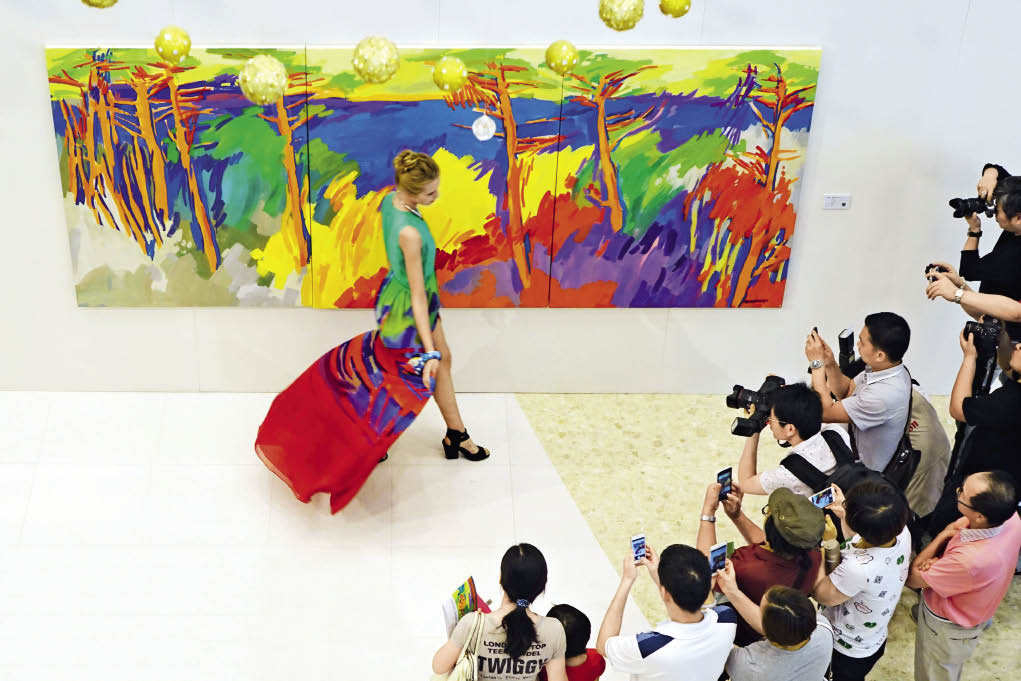The Silk Capital Embraces the World
By staff reporter CHEN JING
HANGZHOU, a paradise on earth, is known to the world not only for its gorgeous landscape, but also as a thriving commercial city. Its long history has enriched the city with profound cultural heritage. Silk, a time-honored product of China, has always been a primary export and cultural representation of Hangzhou.
“The Most Beautiful and Splendid City in the World”
A statue of Marco Polo by the West Lake in Hangzhou depicts the renowned Italian traveler taking a stroll around the lakeside and appreciating the stunning scenery, a book in one hand and a quill in the other.
Marco Polo visited Hangzhou during the Yuan Dynasty (1279-1368). Nearly one tenth of The Travels of Marco Polo talks about Hangzhou. Marco Polo praised the city as the most remarkable of its kind in the world for both its grandeur and beauty. He further marveled at the countless historical sites that embellished it with paradisiacal nature. The book contains Marco Polo’s descriptions of the West Lake, elegant houses and pavilions, as well as boats and carriages loaded with daily necessities ceaselessly traveling along Hangzhou’s canals and streets. Furthermore, he reckoned that the number of bridges in the city amounted to more than 12,000.

A visitor admires a silk robe worn by Emperor Qianlong (1711-1799) in a silk museum in Hangzhou.
The traveler was particularly impressed by locals’ silk garments and regarded this as a highlight of the city. He also could not help noticing that, like women, men in this area have smooth skin and a demure attractiveness. He especially praised the local women for their delicate features. Marco Polo described local women who usually wore exquisite silk clothes and fine jewelries. He dubbed Hangzhou as “the most beautiful and splendid city in the world.” Today, this compliment is carved on the pedestal of Marco Polo’s statue, witnessing the time-honored charisma of the city that is as noble and elegant as the silk it is home to.
Reaching Out to the World Through the Silk Road
The history of silk making in Hangzhou dates back to a time much earlier than Marco Polo’s report. In the period of the Liangzhu Culture, 4,000 to 5,000 years ago, people in the area had mastered the skills of silkworm breeding and silk making. During the Spring and Autumn Period (770-476 BC), Goujian, king of the Yue State, launched measures to support the development of sericulture in a bid to enrich the state. During the Tang Dynasty (618-907), Hangzhou-made silk was often presented as an imperial tribute. The city grew to become the center of silk manufacturing in the Southern Song Dynasty (1127-1279) as almost every household was engaged in silkworm breeding and silk making. Hangzhou, along with neighboring Jiaxing and Huzhou, is the cradle of sericulture and silk products. Silk fabric, with more than 4,600 years of history, is among one of the archaeological findings unearthed at the Qianshanyang Site in Huzhou.
As an export commodity, silk was transported to the Western Regions by way of the Silk Road in the Han (202 BC-AD 220) and Tang dynasties. Thanks to the rapid progress of foreign trade in the Song (960-1279) and Yuan (1279-1368) dynasties, silk products made in Hangzhou were sold to Southeast Asia and the Arab world. The transmeridional Silk Road and the south-to-north Maritime Silk Road played an important role in bringing silk to the world. These passages have always been of great significance to China’s economy and culture.

A cultural custodian demonstrates traditional silk weaving skills.
According to Lou Yisheng, a professor at Zhejiang University’s History Department, Hangzhou owns unique status and profound significance with regard to the silk roads in respect of its history and geography, as it links the silk routes on both land and sea. China’s Grand Canal connects major cities including Hangzhou in the south, Kaifeng and Luoyang at the center, as well as Chang’an (today’s Xi’an) in the north. Located on the extended route of the Silk Road on land, and on the southeast coast of China, Hangzhou served as a key intersection of the overland and maritime trade routes. Facilitated by its favorable location and silk trade, the city developed into a port of transshipment and an international metropolis.
Today, the Belt and Road Initiative is generating new opportunities for this silk capital. Bao Zhicheng, head of the Institute of Cultural Heritage Study at Zhejiang Academy of Arts, believes that silk represents the gentleness, dignity, thoughtfulness, and affinity that is echoed throughout Chinese culture. Seres, the name China was called by ancient Greeks, refers to a silk-producing country and reveals the cultural influence of silk more than 2,000 years ago. Bao notes that based on the opportunities brought about by its strategy, Hangzhou is expected to fulfill its mission to facilitate silk and Eastern culture globally.
Embrace the World
To better fulfill its mission, the Hangzhou Tourism Commission launched the Hangzhou China Global Tour in July 2015. This was a response to the philosophy of adopting tourism as a form of diplomacy advocated by China National Tourism Administration. Participants spent one month traveling across several countries in Asia and Europe, tracing the ancient Silk Road, and further to the U.S. to inherit the cultural connotations of the Silk Road and elevate the visibility of Hangzhou.

A model parades silk garments designed according to an artist’s painting on display at an art show in Hangzhou on June 13, 2016.
A taxi driver from China, Zhou Zhen, and Domenick Capaldi, a musician from the U.S., were selected as the city’s tourism ambassadors. Along with their families and two media reporters from both countries, the ambassadors spread happiness and built lasting international friendships along the way during their journey.
Having taught himself English, Zhou Zhen, a native of Hangzhou, has always been passionate when introducing his hometown to overseas visitors. Renowned writer Chen Zufen mentioned Zhou in her book about Hangzhou in modern times published in 2006, saying that “those who would like to learn about China in the present day are advised to talk to a local taxi driver; Jerry is his English name.” In addition to being friendly, enthusiastic, and considerate to foreign tourists, Zhou has a sense of responsibility and honor. A French couple once asked Zhou whether they could charter his car at a lower price. Upon learning that they had traveled to Hangzhou to search out ancient Chinese cultural relics, Zhou helped them contact the Hangzhou Tourism Commission and provided his car and travel services for free. In Zhou’s eyes, providing quality and convenient service is more meaningful than making profit when it comes to promoting Chinese culture. He is entitled “grassroots ambassador” of Hangzhou for his dedication.
His counterpart Domenick Capaldi is also a Chinese culture enthusiast. He comes from a musical family in which four languages, including Chinese, are spoken. The Capaldis stood out in the short video audition for the tour. On his first trip to Hangzhou, Capaldi got the feeling of the world as a family. “The city makes us feel more like family and friends than foreigners,” he said.
Silk was a key element of the entire global tour. In Dunhuang, a historically important city on the Silk Road in northwest China, the two families exchanged silk products with local residents for a toy camel. On the cruise ship to Mykonos Island of Greece, silk was given as a present to the captain. In Venice, they exchanged silk fans for Italian lace fans. A product with a long history and a symbol of culture, silk owns a unique appeal. A source of fascination to people who cherish Eastern culture, it is an emblem of the city’s openness to the world. In his travel blog, Zhou said that the Silk Road is a route for culture and technology rather than merely for trade. He wrote that “Tea and silk have facilitated promoting Chinese culture to the West. Today, we are striving to revive this historical glory with international friends.”
According to Li Hong, director-general of the Hangzhou Tourism Commission, the Silk Road in the modern era is expected to bring Hangzhou culture to the world stage. Li reckoned that “Covering Asia, Europe, and the U.S., the Global Tour has not only presented Hangzhou to overseas tourist markets, but also inherited the cultural connotation of the Silk Road and elevated the visibility of Hangzhou.”
Enjoying fame for its silk products, Hangzhou is also a livable city. Grasping the opportunities generated by the Belt and Road Initiative, Hangzhou seeks to better embrace the world.
